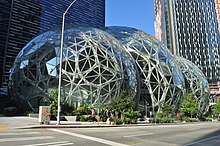What Does Amazon Do With Returns In 2022? (Full Guide)

Logo since 2000
|
|
 |
|
| Amazon | |
| Formerly | Cadabra, Inc. (1994–1995) |
| Type |
Public |
|
|
|
ISIN |
US0231351067 |
| Industry | |
| Founded |
July 5, 1994 ( 1994-07-05 ) Bellevue, Washington , U.S. |
| Founder |
Jeff Bezos |
| Headquarters |
,
U.S.
|
|
Area served
|
Worldwide |
|
Key people
|
|
| Products | |
| Services | |
| Revenue |
US$ 469.822 billion (2021) [1] [2] |
|
US$24.879 billion (2021) [1] |
|
|
US$33.364 billion (2021) [1] |
|
|
Total assets |
US$420.549 billion (2021) [1] |
|
Total equity |
US$138.245 billion (2021) [1] |
| Owner |
Jeff Bezos (14.0% voting power, 10.6% economic interest) [3] |
|
Number of employees
|
1,608,000 (Dec. 2021) [1] U.S.: 950,000 (Jun. 2021) [4] |
|
Subsidiaries |
List
|
| Website |
amazon.com |
|
Footnotes / references [5] [6] |
|
Amazon, one of the most prominent names in ecommerce with millions of household items that can be ordered with just a few clicks from their smartphones or computers around the globe.

Amazon’s 2021 Returns Policy: What is it doing?
Amazon sells returned products on Amazon Warehouse and to ecommerce liquidation resellers. Some returned items may get refunded by Amazon. But the vast majority of returns are sent on pallets for bulk sales to Liquidation.com.
You can read on to find out more information about Amazon and its return policies.
How does Amazon’s return process work
Amazon ships items worldwide and offers customers the opportunity to return them within 30 business days.
Amazon, as well as most third-party sellers, offers this generous return policy. However some products may have different returns policies.
Amazon says it could take as long as 25 days for your returned product to reach the fulfillment center. The fulfillment center will then process the refund within a few business days.
Once the return is received at the fulfillment center, the refund will be processed and an item may then be listed on Amazon Warehouse.
Otherwise, it’s prepared for liquidation with many other returned products.

Which Amazon Products Can Be Returned?
Amazon processes returned items and then distributes them accordingly to their warehouses.
Amazon Warehouse might accept gently used items (e.g., those the customer changed their mind about or the incorrect item).
The rest of the returned products are packaged on pallets in the storerooms, which are then sold in bulk to liquidation companies.
Amazon stock can be purchased cheaply by liquidators. Then, they take those pallets and then sell them to other liquidators.
Liquidation.com, for example, is a marketplace where B2B buyers can liquidate items from Amazon and other mass-market retailers such as Target, Home Depot and Lowes.
Which Items Can Be Returned to Amazon?
Amazon offers many options for returning items, but only if the seller has specific policies.
Amazon returns are accepted for a majority of household goods, including clothes, pet supplies, tools, or accessories.
You can resell these products on Amazon Warehouse, or through liquidation companies.
Some things like grocery items or downloadable software may not be returned, and it should be stated clearly on the product listing and in your account orders if it’s eligible for returns or not.
Amazon’s small business customers account for more than half of all units. Amazon offers a liquidation scheme for products that have been returned.
It is often unnecessary to invest the labor and time to return a product to Amazon.
That’s why Amazon chooses to liquidate returned items through mass liquidation warehouses.
You can think of it like this: If Amazon had the resources to go through each item that is returned and checked for quality before packaging it again, then it could save the seller valuable time.
Everyone wins by quickly processing returns and selling returned products on Amazon Warehouse, or to third-party liquidation sites.
Amazon and its millions of sellers get to keep more money and resources instead of tying them up in individual returns.
You can rest easy knowing that your returned product will usually be given another chance. However, it’s not possible to guarantee that each item will ever be resold.
What Does Amazon Do With Returns In 2022? (Full Guide)
